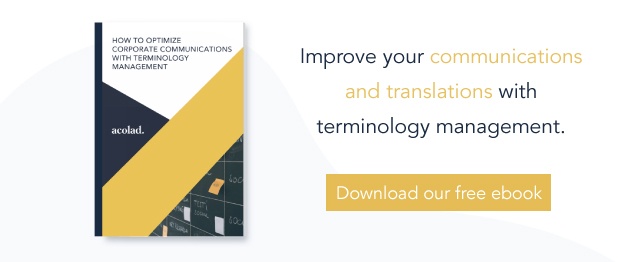-1.png?width=950&name=Untitled%20design%20(2)-1.png) We can't tell you the number of prospects and customers we have encountered who struggle with inconsistent terminology across their departments. Corporate terminology represents a company-wide standard and should therefore be used consistently by all departments and suppliers.
We can't tell you the number of prospects and customers we have encountered who struggle with inconsistent terminology across their departments. Corporate terminology represents a company-wide standard and should therefore be used consistently by all departments and suppliers.
A typical example of mediocre terminology management is when a company's technical department names things differently to the marketing team, or when the sales department adopts a whole different set of terms during customer meetings and in presentations. Naturally, this only creates unnecessary hassle that could actually jeopardize the team's work. But have you thought of the possible legal consequences of using incorrect terminology?
Terminology management is fundamental to multilingual technical documentation
If this unfortunate situation is familiar to you, don't panic! It can be solved by implementing appropriate terminology management. By regulating the use of terminology, you will be able to:
- improve the quality of your multilingual corporate content;
- avoid costly misunderstandings caused by incorrect usage of terms;
- facilitate translation work in other languages.
In this blog post, we will explain the first steps to building a terminology database (or termbase), illustrating common challenges and sharing a practical example with you.
How to build a terminology database
A termbase is essentially a database of specialist terms. Terminology work starts with a project, during which the terminologist defines the termbase design and structure, the terminology tools to be used, and the management procedures to be implemented.
The first steps to developing proper terminology management are as follows:
- Collect and analyze all current material with a view to extracting all the relevant terms to be harmonized: although this task is the responsibility of a terminology specialist, it can only be completed successfully with the involvement of all departments, suppliers and/or external services.
- Identify and extract your terminology: this is a linguistic process that requires the work of an expert. It consists in detecting synonyms, homographs and morphemes, as well as any inconsistencies. This will form the basis for setting up your termbase.
- Make sure the company establishes a terminology guideline, so as to be able to maintain and manage the multilingual termbase with ease.
Challenges involving terminology databases: the case of synthetic languages and linguistic agglutination
Building a termbase requires specialized knowledge of the languages involved. In this example, we will illustrate the issues that arise when dealing with agglutination in synthetic languages such as German.
To start with, let’s define “agglutination”: Aggluti-what? Scary word, right?
In linguistics, “agglutination” is a morphological phenomenon whereby one or more affixes are added to a root word in order to express different linguistic categories (for example, plural, singular, noun case, etc.). The word comes from the Latin verb “agglutinare”, which means “glue together”.
We were asked by a client how we managed termbase entries in a language that declines nouns. In particular, our customer wanted to know if we could set up a terminology database capable of suggesting all the possible forms of a noun, considering that it might appear in a text in various declensions.
For example, he mentioned the behavior of the German word “Haus”:
- Dort steht ein schönes Haus (There stands a lovely house)
- Er trinkt Wein des Hauses (He drinks wine from the house)
The question
Our customer wanted to know, would both the terms “Haus” and “Hauses” be specified in the termbase, along with all the other possible declensions of the root noun?
The answer
We had no straight answer to give, so we turned to our terminology management expert for help. She explained that setting up a terminology database with agglutinative languages is not an issue. According to the rules of terminology (applicable to any language), terms should be entered in the termbase in their basic form, i.e. singular, masculine, lower case. It is not advisable to enter all the declined forms of a term because a terminological database is not a grammar book - it registers concepts and terms, but not their declined forms.
Ok, so terms are entered in the termbase in their basic form. But, surely, those same terms are likely to appear in their declined form in the document to be translated? Would that not pose the risk of their not being recognized by the terminology management system? Luckily for us, most terminology management systems have features to solve this issue.
For example, you can isolate the stem of the word, so that the system ignores what comes before or after. This you can do by using wildcards such as asterisks or pipes. For example, if we put a wildcard after Haus (i.e. Haus*), then the termbase will also recognize the term Hauses should it appear in the document to be translated. And for more advanced termbase users, when entering a term into the termbase, you can set a “match value”, i.e. the similarity, expressed as a percentage, between terminology in the source segment and the matching terminology found in the termbase.
If you are concerned about agglutination, bear in mind that professional translators are aware of this type of situation. If you need help managing your corporate terminology, feel free to contact us!
Download our free e-book about terminology management!


